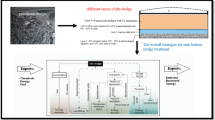Abstract
Some Ordovician and Triassic oils in Block 9 are characterized by light oils, which have distinctly differentiated from heavy oils in other blocks in the Tahe Oilfield, Tarim Basin. Based on the whole oil gas chromatograms, this paper estimates the effect of oil migration and fractionation and the amount of depletion (Q) in terms of the n-alkanes depletion model. The results showed that the amount of depletion in the Ordovician reservoir is highest in the east of this block, e.g. the depletion is 97% in Well T904. The amount of Q gets lower to the west, e.g. the depletion is 53.4% in Well T115 and there is no sign of depletion in Well S69. It is suggested that the direction of gas washing is from the east to the west. The compositions and isotopic characteristics of associated gas in Ordovician oils indicated that the gas might be derived from Cambrian source rocks of the Caohu Depression which lies to the east of Block 9. In contrast, no obvious depletion of n-alkanes in Triassic oils was found, suggesting that the migration pathway of natural gas has been limited to the Ordovician karst fracture system formed in the Early Hercynian Orogeny. Different depletions of the Ordovician and Triassic oils can reveal fault activities in this region.
Similar content being viewed by others
References
Curiale J.A. and Bromley B.W. (1996) Migration induced compositional changes in oils and condensates of a single field [J]. Organic Geochemistry. 24, 1097–1113.
Dai Jinxing, Qi Houfa, Song Yan, and Guan Deshi (1986) The components and carbon isotopes of coal bed gases in China and origin [J]. Science in China (Series B). 16, 1317–1326 (in Chinese with English abstract).
Dzou L.I. and Hughes W.B. (1993) Geochemistry of oils and condensates, K field, offshore Taiwan: a case study in migration fractionation [J]. Organic Geochemistry. 20, 437–462.
England W.A. (2002) Empirical correlations to predict gas/gas condensate phase behavior in sedimentary basins [J]. Organic Geochemistry. 33, 665–673.
Huang Difan, Liu Baoquan, Wang Tandong, Xu Yongchang, Chen Shijia, and Zhao Mengjun (1996) Genetic types of natural gases and their maturity discrimination in the east of the Tarim Basin [J]. Science in China (Series D). 39, 659–669.
Kissin Y. (1987) Catagenesis and composition of petroleum: Origin of n-alkanes and isoalkanes in petroleum crudes [J]. Geochimica et Cosmochimica Acta. 51, 2445–2457.
Lafargue E. and Barker C. (1988) Effect of water washing on crude oil compositions [J]. AAPG Bulletin. 72, 263–276.
Liang Digang, Zhang Shuichang, Chen Jianping, Wang Feiyu, and Wang Peirong. (2003) Organic geochemistry of oil and gas in the Kuqa depression, Tarim Basin, NW China [J]. Organic Geochemistry. 34, 873–888.
Losh S., Cathles L., and Meulbroek P. (2002) Gas washing of oil along a regional transect, offshore Louisiana [J]. Organic Geochemistry. 33, 655–663.
Losh S. (2010) Phase fractionation and oil-condensate mass balance in the South Marsh Island Block 208–239 area, offshore Louisiana [J]. Marine and Petroleum Geology. 27, 467–475.
Lu Hong, Jia Wanglu, Xiao Z.Y., Sun Y.G., and Peng Pingan (2004) Constraints on the diversity of crude oil types in the Lunnan Oilfield, Tarim Basin, NW China [J]. Chinese Science Bulletin. 49(suppl. 1), 19–26.
Meulbroek P. (1997) Hydrocarbon Phase Fractionation in Sedimentary Basins [D]. pp.344. Cornell University.
Meulbroek P., Lawrence C., and Whelan J.K. (1998) Phase fractionation at South Island Block 330 [J]. Organic Geochemistry. 29, 223–239.
Schoell M. (1983) Genetic characterization of natural gases [J]. AAPG Bulletin. 67, 2225–2238.
Stahl W.J. (1974) Carbon isotope fractionation in natural gases [J]. Nature. 251(5471), 134–135.
Su Aiguo, Zhang Shuichang, Han Dexing, and Wang Tingbin (2004) Behavior of chain alkane molecular components in PVT fractionation experiment [J]. Acta Sedimentology Sinica. 22, 354–358 (in Chinese with English abstract).
Sun Yongga, Xu Shiping, Lu Hong, and Cai Pingxia (2003) Source facies of the Paleozoic petroleum systems in the Tabei uplift, Tarim Basin, NW China: implications from aryl isoprenoids in crude oils [J]. Organic Geochemistry. 34, 629–634.
Thompson K. (1987) Gas condensate migration and oil fractionation in deltaic systems [J]. Marineand Petroleum Geology. 5, 237–246.
Van Graas G.W., Gilje A.E., Isom T.P., and Tau L.A. (2000) The effects of phase fractionation on the composition of oils, condensates and gases [J]. Organic Geochemistry. 31, 1419–1439.
Wang Feiyu, Zhang Shuichang, Zhang Baomin, Xiao Zhongyao, and Liu Changwei (2003) Maturity and its history of Cambrian marine source rocks in the Tarim basin [J]. Geochemistry. 32, 461–468 (in Chinese with English abstract).
Wang Tioguan, He Faqi, Wang Chunjiang, Zhang Weibao, and Wang Junqi (2008) Oil filling history of the Ordovician oil reservoir in the major part of the Tahe Oilfield, Tarim Basin, NW China [J]. Organic Geochemistry. 39, 1637–1646.
Wu Nan, Cai Zhongxian, Yang Haijun, Chen Jianyu, Liu Xianfeng, and Gu Qiaoyuan (2009) Quantitative evaluation and the geochemical responses of gas washing in Lunnan petroleum province [J]. Earth Science Journal of China University of Geosciences. 34, 486–492 (in Chinese with English abstract).
Yang Chupeng, Geng Ansong, Liao Zewen, Sun Yongge, and Zhang Luhui (2009) Quantitative assessment of gas washing of oils in the Tazhong area of the Tarim Basin, Northwest China [J]. Science in China. 52, 12–21.
Zhang Shuichang, Hanson A.D., and Moldowan J.M. (2000) Paleozoic oil-source rock correlations in the Tarim Basin, NW China [J]. Organic Geochemistry. 31, 273–286
Zhang Shuichang (2000) The migration fractionation: an important mechanism in the formation of condensate and waxy oil [J]. Chinese Science Bulletin. 45, 1341–1344.
Author information
Authors and Affiliations
Corresponding author
Rights and permissions
About this article
Cite this article
Cui, J., Wang, T., Wang, C. et al. Quantitative assessment and significance of gas washing of oil in Block 9 of the Tahe Oilfield, Tarim Basin, NW China. Chin. J. Geochem. 31, 165–173 (2012). https://doi.org/10.1007/s11631-012-0563-5
Received:
Accepted:
Published:
Issue Date:
DOI: https://doi.org/10.1007/s11631-012-0563-5




